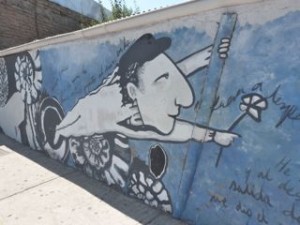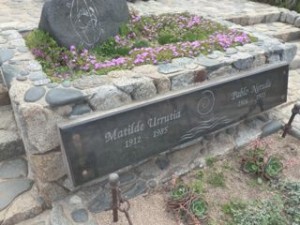STANDING over Pablo Neruda’s grave, a young attendant named Lorena said she wasn’t sure about any of this. The exhumation had not yet begun, and the flowerbed looked undisturbed above the poet’s burial mound at Isla Negra, just outside his former home on the rocky black volcanic coast of Chile. But court-appointed investigators had already been out to survey the site and measure the depth of the remains. Asked for her opinion on Neruda’s cause of death, Lorena told me that she didn’t know what to believe. “There’s a lot of stories, but no proof,” she said. Essentially, there are only two stories. The one in which Neruda died of prostate cancer, as was commonly believed until recently. And the one in which he was murdered by Chile’s self-appointed military leaders—poisoned to death on their orders—just a few days after they seized power in the coup d’etat of September 11, 1973.
The first version of events was the official one throughout the seventeen-year dictatorship that followed, and long into the modern era of nominal democracy. The cancer story is also the one visitors hear on the multilingual audio-guides dispensed by Lorena and her colleagues here at Isla Negra, where Neruda kept one of the three houses he owned in Chile. All three are now popular museums and tourist attractions, operated by the Pablo Neruda Foundation. In the weeks before the exhumation, I visited each of them.
At La Chascona, the house in Santiago, an English-speaking guide named Alexandra said that the foundation was “neutral” on the question of assassination. “We are waiting for the new post-mortem,” Alexandra said, as she talked me through the poet’s bedroom, his “Captain’s bar,” and the “French room” full of artefacts from Neruda’s years in Paris, where his close friend President Salvador Allende had appointed him ambassador. Allende’s corpse was also recently exhumed, to confirm whether his fatal gunshot was truly self-inflicted on the day of the coup. Though his apparent suicide was accepted by family and supporters as a last brave gesture of defiance, suspicions persisted for decades and flared up when a secret military document on his death was discovered in the former home of a senior official after the earthquake of 2010.
A second autopsy, however, upheld the original verdict, leading many Chileans to question the current government’s commitment to retroactive justice. “A lot of top people from the dictatorship are still in powerful positions today,” Alexandra observed mildly. One legacy of that period is a volatile compound of cynicism and populism in which every attempt to address the dictatorship’s abuses can be read as pandering to an electorate for whom the past is still a live issue.
Neruda, for his part, believed that Allende was murdered, and wrote as much in the last pages of his autobiography, before he was taken to the Santa Maria clinic for cancer treatment. He died there shortly after. This house, a short walk away, had been ransacked by soldiers during the coup, and his funeral procession began here as a thinly veiled public protest against the forces of General Augusto Pinochet. Given his eloquence and influence, his status as a widely read, respected, and beloved figurehead of the left, Neruda was no less an enemy of the new state than was the socialist President Allende or the activist and folk singer Victor Jara. Jara’s guitar-playing hands were broken at the wrists, and his body was riddled with bullets in the chaos of the takeover. Another legacy of those days is an abiding state of fear. In 2011, when Neruda’s driver Manuel Araya claimed that the poet had been given a mysterious injection on the afternoon of his death, he cited that fear as his sole reason for not coming forward earlier. According to Araya, that shot made Neruda “hot, red, and feverish” and killed him within hours. That allegation alone compelled surviving relatives and former comrades from the Chilean Communist Party to file a criminal lawsuit.
The subsequent investigation under judge Mario Carroza has turned up a wealth of anecdotal and circumstantial evidence—witnesses attesting to Neruda’s relative good health and plans to live in exile in Mexico, ominous remarks made on state-controlled radio stations shortly before his death, rumours of an elusive “Doctor Price” who supposedly administered the fatal injection and has never been seen since. Also in 2011, the exhumation of Salvador Allende’s predecessor Eduardo Frei Montalva—in his later years a vocal opponent of the dictatorship—revealed that the ex-president had been secretly poisoned to death at the same Santiago clinic in 1982. Alexandra betrayed a slightly ironic tone as she outlined what she knew of the case. Leaving La Chascona, I suggested that she must have her own informed ideas about what happened to Neruda. “Yes,” she said, but she did not elaborate further.
At La Sebastiana, the poet’s wonderful split-level house in the hills above Valparaiso, a gift shop assistant named Christian was prepared to venture his opinion, though he stressed that it was “personal” and not that of his employers. “From everything I’ve heard and read, I think it was murder,” he said. “Neruda had cancer, but he wasn’t that sick. It wasn’t so . . . terminal.” Christian then went a little further, to remind me that the Pablo Neruda Foundation was itself formed in the mid-1980s under the same regime that had banned and burned Neruda’s work.
“Some people” still thought the president of the foundation, Juan Agustín Figueroa, was more a friend of Pinochet’s than Neruda’s, Christian said. And he added that the foundation had initially opposed the exhumation. Then he went to find a container for the print I wanted to buy: a hand-painted cross-section of this house, my favorite of the three. But Isla Negra was the closest to Neruda’s heart, and it remains the biggest draw for his readers and followers.
After his death it took more than twenty years, and the end of the dictatorship, for his body to be brought here from Santiago and reburied next to his wife Matilde Urrutia, per his wishes. Lorena, the young audio-guide attendant, said it seemed like a shame to disturb them now. One of her male colleagues, also young, affected not to care. “I’m just glad that they’re not making us dig him up,” he said. The exhumation was performed on Monday, April 8, by an international team of forensic scientists. The results will not be known until later in the year, and even then might not be conclusive. The team must contend with a lack of medical records on Neruda’s illness and a lack of physical evidence to sample—decades of salt spray from the Pacific have corroded the poet down to bare bones. The hope is that those bones will show the extent of his cancer, or telltale traces of poison, where the marrow used to be.
This thought inspired Hernan Garrido, a visiting Columbian poet (pen name: Ricardo Jhalet), to write an ode to Neruda’s remains at Isla Negra. Garrido recited it in Spanish, and I wrote down as much as I could catch in English: “Your bones will rise / They will wake up as more than a man / They will walk through the streets / And speak thousands of verses, through the mouths of millions.”


Leave a Reply